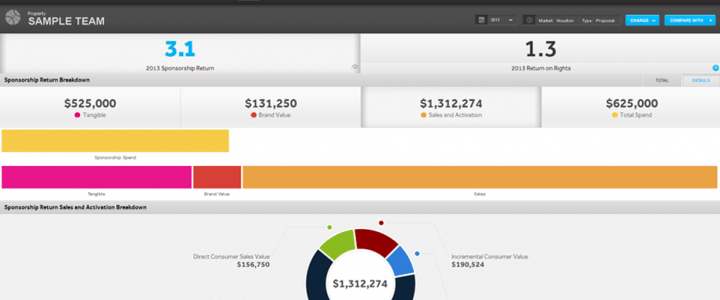“If I had a dollar to spend on marketing why would I spend it on sponsorship?”
–Typical CMO
If I had a dollar for every time I’ve been asked a variation of that question over the years, I could probably afford a nice presenting sponsorship somewhere.
One of the many challenges facing CMO’s these days is how to best deliver a return on investment on their marketing spend. Unfortunately, sponsorship marketing is one of the least understood marketing channels and it is often one of the first channels to be asked to take a cut when those are necessary.
We marketers could potentially avoid that cut if we’re able to effectively capture (and communicate) our sponsorship return. In order to do so, we have to collect and measure numerous direct and indirect variables. We’ll need to measure the various elements included in exchange for our spend and the broader impact of your activation programs while also having a solid understanding of your market share, target customer, annual & lifetime value and a variety of other internal metrics.
Ultimately, since every sponsorship has different entitlements and each business has different metrics, there’s not one easy way to measure a return. It’s not like some other channels where $1 spent will get me xxx impressions or xx click-throughs.
No Soup For You! Next…
The result of this complicated sponsorship measurement process is that many companies have shied away from trying to truly measure their sponsorship return. In this era of short attention spans and “just bottom-line it for me” management it’s often easier for a Marketing Exec to justify to a CEO that we’re going to spend $XX get this many impressions/clicks or this TV rating or hit these listeners than to try explain the many different variables that should go into capturing sponsorship return.
But I Was Told There Would Be No Math…
If you’re looking for a short, easy response to the question of why sponsorships are valuable, then choose any one (or all) of these: Sponsorships…
- Provide our brand with a way to break through the clutter in ways that traditional media can’t do.
- Result in getting our customers to buy more product at a higher prices and stay with us longer.
- Offers our business a completive advantage and force our competitors to spend more to keep up.
- Amplify the results of all our other marketing channels leading to better results overall.
It’s Not Just Tickets and Signs?
No. Over the years, I’ve been fortunate to work with some really smart people and together we’ve defined, redefined and refined the various elements that go into measuring sponsorship return for the brands we’ve worked with.
While every business is different there are some “typical” elements that you should be capturing when measuring a return on your sponsorship spend. Here are just a few:
- Brand Metrics (Awareness, Preference, Selection) – Numerous studies over the years have shown than sponsorships can move the needle for brand metrics when consumers are aware of the sponsorship. You need to figure out how an increase in any or all of these metrics impacts your revenue?
- Traditional Media (TV, Radio, Print, etc.) – What’s the traditional media value of the assets and how did they perform against expectations? This may be the most straight-forward of all of them…
- Digital Media (Online, Social, Mobile) – Brands have increasingly stressed the need to engage consumer beyond the stadium. Online, Social and Mobile elements should be part of any activation plan but you should also have a plan for not just tracking but also placing a value on the engagement you get from those elements.
- Sales Metrics (Both New & Retained) – How many direct sales did your sponsorship deliver, how many customers did it help to retain? How much money are you saving by keeping the old customers? How did your sponsorship impact the broader market – the people who knew you were a sponsor but didn’t buy directly or right away.
- Hospitality – We often measure this in how much did a ticket or the access cost, but you should also consider how valuable the people you’re inviting are and how much additional business you are able to generate from them.
- Customer Engagement – None of the other metrics matter much if people don’t know that you’re a sponsor of the property. You should be working to develop activation programs that try to engage the largest possible, relevant audience.
- Employee Engagement – Do you use you sponsorship to motivate employees? How much more productivity to you get from employees with higher morale? Does it have an impact on employee retention?
- Property Alignment – The property itself can make a difference. You don’t have to be aligned with the biggest and most popular property in your target market but you should be aligned with the right property. You need to understand how the property lines up with your target customer, how you’ll fit in with the property’s other sponsors and how good (or difficult) they are to work with. Any or all of these can impact overall performance.
Again, this list isn’t meant to be an all-inclusive list or the right list for every business. Hopefully, it’s gotten you thinking about how you’re currently measuring your sponsorship ROI and given you some additional ammunition to answer the “$1 to spend” question the next time you’re asked.
This Is Great But How Does This Apply to the Property Side?
Having worked with hundreds of properties and reviewed thousands of proposals, I can probably count on two hands the number of times a property asked me about how we’re going to measure the results. By asking the question and gaining an understanding of exactly what the sponsor is going to measure, properties can help themselves by delivering the assets that are going to drive the best results for the sponsor. A sponsor that can point to a positive ROI on sponsorship spend is more likely to renew or increase their spend than a sponsor that doesn’t have any results to speak of. Just saying…
Thanks for reading. Now it’s your turn. What elements are you measuring to capture sponsorship return?


